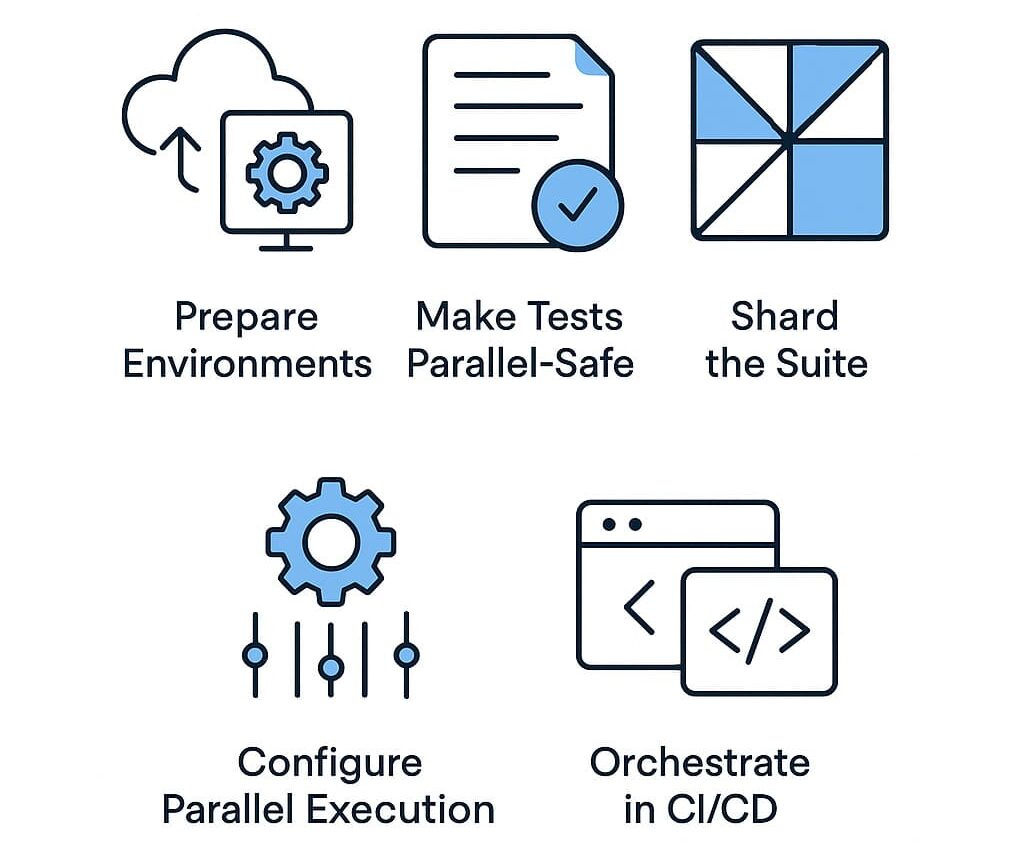Parallel Testing in Software Testing | Comprehensive Guide 2025

The speed of application delivery has become the most critical element in contemporary software development. However, sequent testing tends to prolong the release and feedback cycle and can be a bottleneck in the CI/CD pipeline. This is how parallel testing in software testing comes in.
Teams can triple productivity and coverage test execution times, shorten feedback loops, and increase coverage by performing parallel testing in different browsers, devices, and environments without compromising quality. In this guide, we will go into what parallel testing is and why we practice it, some real-world use cases, best practices, and the tools that facilitate parallel testing.
Whether you are a QA engineer, DevOps engineer, or test manager, you will be able to understand how to use parallel testing and incorporate it into your automation framework.
- What Is Parallel Testing in Software Testing?
- Why Testing in Parallel Matters: Key Benefits
- When to Use Parallel Testing?
- Parallel Testing vs. Sequential Execution
- How to Implement Parallel Testing (Step-by-Step)?
- Parallel Testing in Automation Frameworks
- Automated Parallel Testing Tools to Consider
- Limitations of Parallel Testing (and How to Mitigate)
- Example: Cross-Browser Login in Parallel
- Best Practices Checklist
- Quick Start: From Zero to Parallel
- Conclusion
What Is Parallel Testing in Software Testing?
Parallel testing in software testing executes multiple test cases concurrently rather than sequentially. By distributing suites across machines, containers, or cloud grids, teams accelerate feedback loops, improve coverage across configurations, and reduce overall build time – crucial for agile releases and DevOps.
Parallel Testing vs. “Parallelization Testing”
Parallelization testing is used interchangeably. Both refer to automated test parallelization – splitting work into independent chunks that can run at once without stepping on each other’s data or environment state.
Why Testing in Parallel Matters: Key Benefits
Parallel testing delivers faster execution, higher coverage, and improved productivity, making it a cornerstone for agile testing teams and DevOps-driven pipelines.
- Time efficiency: Slash wall-clock time for large suites by running them simultaneously.
- Faster feedback: Catch regressions early; keep developers unblocked and PRs small.
- Improved test coverage: Validate across OS/browser/device combinations in one run.
- Cost control: Use elastic cloud infrastructure and right-size concurrency to avoid idle hardware.
- Higher productivity: Offload long suites; let engineers focus on analysis, exploratory testing, and quality strategy.
When to Use Parallel Testing?
Not every project requires parallelization. It’s most valuable in scenarios like CI/CD, regression, cross-browser testing tools/device validation, and time-sensitive releases.
- CI/CD pipelines: Keep builds under the team’s target SLA (e.g., <10–15 minutes for smoke, <30–45 minutes for full).
- Regression testing: Large suites run faster without compromising depth.
- Cross-browser/device testing: Prove compatibility testing by fanning out across Chrome, Firefox, Safari, Edge; iOS/Android.
- Time-critical releases: Hotfixes and compliance drops that can’t wait.
- Performance/load baselines: Orchestrate concurrent functional sessions as part of broader performance probes.
Parallel Testing vs. Sequential Execution
Comparing sequential and parallel testing shows why modern QA favors concurrency; parallel execution accelerates builds, improves reliability, and fits seamlessly into CI/CD.
To Know More, Please Read – Why test automation makes parallelization practical?
| Dimension | Sequential | Parallel |
|---|---|---|
| Total time | Long (sum of tests) | Short (max of slowest shard) |
| Feedback | Delayed | Rapid |
| Infra usage | Low, often underutilized | Elastic, right-sized |
| Flakiness exposure | Hidden until late | Surfaces earlier (good for quality) |
| CI/CD fit | Risk of slow gates | Designed for modern pipelines |
How to Implement Parallel Testing (Step-by-Step)?
Successful parallel test execution requires careful setup, standardizing environments, making tests independent, sharing suites, and configuring CI/CD pipelines.

1) Prepare Environments
- Standardize images (containers/VMs) so every node matches prod-like settings.
- Provision concurrency using cloud grids, Kubernetes, or ephemeral runners.
2) Make Tests Parallel-Safe
- Isolate state: No shared globals, singletons, or static caches.
- Deterministic data: Use unique test accounts/records; avoid cross-test dependencies.
- Idempotent setup/teardown: Clean fixtures; snapshot/rollback DBs where feasible.
3) Shard the Suite
- By file/class/scenario: Distribute evenly by historical duration to prevent stragglers.
- Dynamic work stealing (nice-to-have): Idle workers pick up remaining tests.
4) Configure Parallel Execution
- Thread/workers: Set via framework (e.g., -n auto in pytest-xdist, workers in Playwright).
- Matrix builds: Use CI to fan out across browsers/OS/Node versions.
- Environment variables: Pass shard index/total shards for seedable splits.
5) Orchestrate in CI/CD
- Fail-fast for smoke: Gate merges quickly.
- Retry smartly: Re-run only failed shards to reduce noise and time.
- Artifacts & logs: Upload per-shard videos, screenshots, HARs, and JUnit XML.
6) Aggregate & Analyze
- Merge reports: One dashboard summarizing pass/fail, duration, flake rate.
- Trend over time: Track mean/95th duration and stability per share and per test.
Parallel Testing in Automation Frameworks
From Selenium Grid to Playwright and Cypress, leading automation frameworks support parallelism with built-in workers, grids, and orchestration features.
Selenium/WebDriver
- Selenium Grid for distributed browsers (local, Docker, or cloud).
- TestNG/JUnit5: parallel=methods/classes, or JUnit5 parallel in junit-platform.properties.
Cypress
- Cypress Cloud splits specs across agents; recordings enable parallel load balancing.
- Use CI matrix to vary Node versions/browsers (Chromium/Firefox/WebKit via component/experimental runners).
Playwright
- Built-in workers (–workers, –shard=1/4), projects per browser, and trace/video artifacts per worker.
- Great default isolation with context-per-test and parallel test execution baked in.
Python/Pytest
- pytest-xdist (-n auto) distributes tests; combine with pytest-rerunfailures for targeted retries.
- Robot Framework users can integrate Pabot for parallel runs.
Mobile (Android/iOS)
- Parallelize across device farms (real or virtual), simulators/emulators, or cloud device grids; keep app/data/account isolation strict.
Automated Parallel Testing Tools to Consider
Choosing the right tools is crucial. Popular options include ACCELQ, Selenium Grid, Playwright Test, and Cypress Cloud each catering to different needs.
- ACCELQ for parallel testing in automation with codeless authoring, cross-channel coverage, CI/CD hooks, and elastic execution, helpful when you want speed without heavy framework plumbing.
- Selenium Grid (self-managed or Dockerized) for granular, on-prem control.
- Playwright Test for first-class parallel workers, sharding, and traces.
- Cypress + Cloud for parallel spec distribution and flake analytics.
- Cloud device/browser grids for elastic concurrency at scale.
⚡ Supercharge Parallel Testing with ACCELQ Autopilot
Eliminate bottlenecks with AI-powered, codeless parallel testing that scales effortlessly across browsers, devices, and environments.
👉 See ACCELQ Autopilot in Action
Limitations of Parallel Testing (and How to Mitigate)
While powerful, parallel testing has challenges such as flaky tests, environment drift, and infrastructure costs. Proper strategy and tools help mitigate these.
- Shared state collisions → Use unique test data, ephemeral test tenants, DB snapshots, and strict teardown.
- Environment drift → Containerize; version configs; bake images and pin browser/driver versions.
- Flaky tests amplified → Quarantine and fix systemic flake (timing, async waits, network stubs). Enable targeted retries with caps.
- Bottlenecked services → Seed predictable test doubles/mocks; rate-limit outbound calls; simulate upstreams.
- Cost spikes → Cap max concurrency by criticality (smoke >> sanity >> nightly); autoscale and rightsize worker specs.
Example: Cross-Browser Login in Parallel
A banking app must support Chrome, Firefox, Safari. Instead of running UI login tests one-by-one, you shard the suite into three parallel projects. Each project spins an isolated browser context, generates unique credentials, and posts results to a unified report. Time drops from 21 minutes to ~8, while browser-specific CSS and cookie issues surface earlier.
Best Practices Checklist
Following parallel testing best practices, like ensuring independence, sharding by duration, and monitoring resources, maximizes reliability and efficiency.
- Tests are atomic, independent, and idempotent.
- Test data is unique per test (GUIDs, timestamped emails, sandbox tenants).
- Suites are sharded by duration to balance workers.
- CI uses matrix builds and fail-fast policies for smokes.
- Flake is tracked as a metric; retries are scoped and capped.
- Reports, videos, and traces are aggregated for single-pane triage.
Quick Start: From Zero to Parallel
Even small teams can adopt parallelization. Start with containerized environments, a few independent tests, and scale with CI/CD matrix builds.
- Containerize your test runner + browser binaries.
- Make 3–5 tests parallel-safe (no shared users/files).
- Turn on workers (pytest -n auto, Playwright –workers, TestNG parallel).
- Add a CI matrix for browsers/OS.
- Upload JUnit XML + artifacts; enforce a smoke gate.
Conclusion
In today’s fast-paced software delivery environment, parallel testing is no longer optional, it’s essential. By replacing slow sequential runs with parallel test execution, teams can shorten release cycles, gain faster feedback, and ensure applications work seamlessly across diverse environments.
While there are limitations of parallel testing, such as resource management, test data collisions, and environment consistency, these challenges can be overcome with the right strategy, frameworks, and automated test parallelization tools. From Selenium Grid and Playwright to cloud-based grids and platforms like ACCELQ, testers now have flexible options to implement parallel testing in automation with scalability and efficiency.
Ultimately, adopting parallel testing means more than just saving time, it’s about building a resilient, future-proof QA process. By mastering how to implement parallel testing in your workflows, and unlock faster delivery, broader coverage, and higher confidence in every release.
Find out how ACCELQ can improve your Parallel Testing today with our demo.
Prashanth Punnam
Sr. Technical Content Writer
With over 8 years of experience transforming complex technical concepts into engaging and accessible content. Skilled in creating high-impact articles, user manuals, whitepapers, and case studies, he builds brand authority and captivates diverse audiences while ensuring technical accuracy and clarity.
You Might Also Like:
 What is Unit Testing? Best Practices to Do it Right
What is Unit Testing? Best Practices to Do it Right
What is Unit Testing? Best Practices to Do it Right
 What is Usability Testing? [Tester’s Beginners Guide]
What is Usability Testing? [Tester’s Beginners Guide]
What is Usability Testing? [Tester’s Beginners Guide]
 Comprehensive Guide to System Testing: Ensuring Software Excellence
Comprehensive Guide to System Testing: Ensuring Software Excellence
































